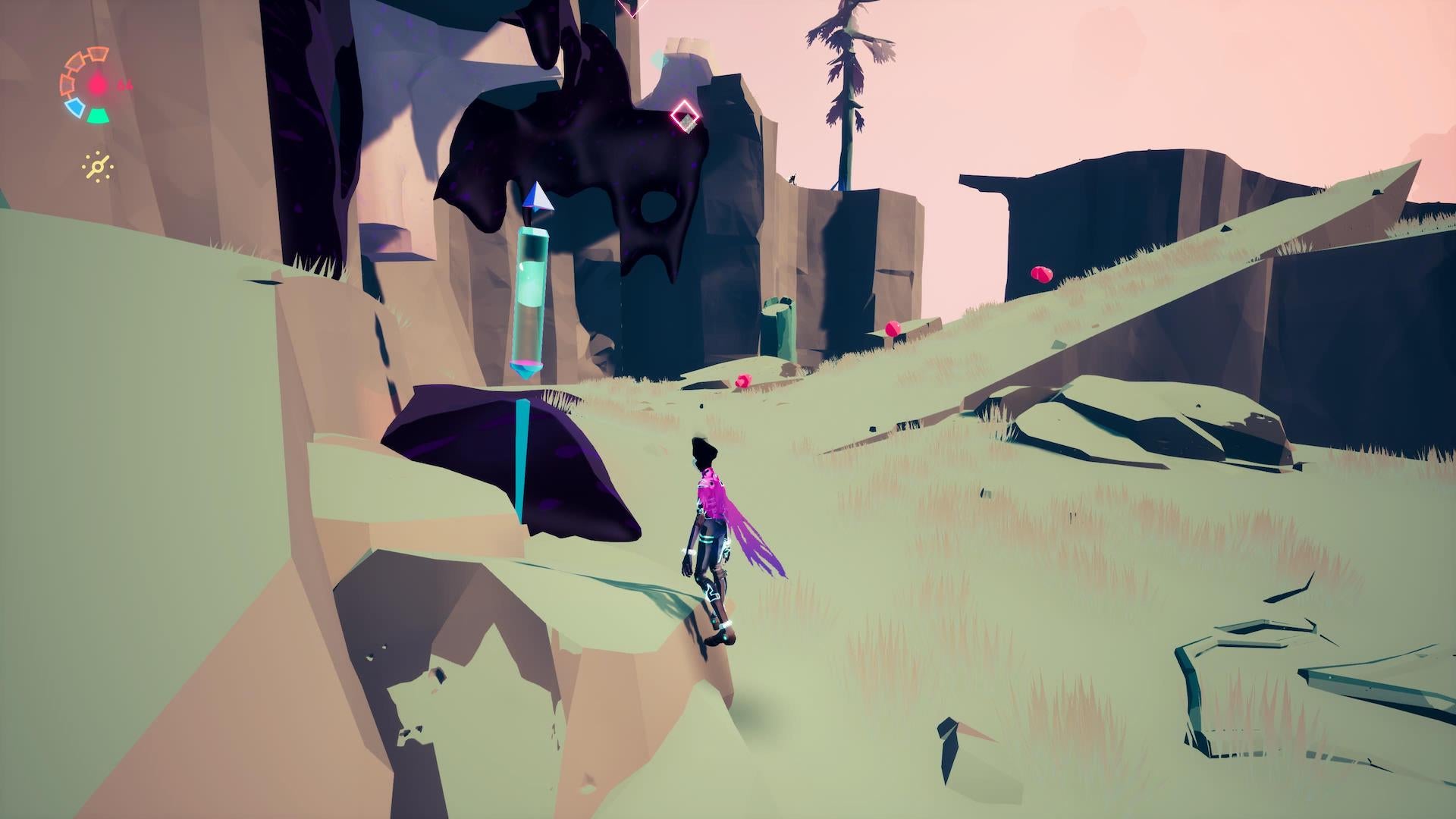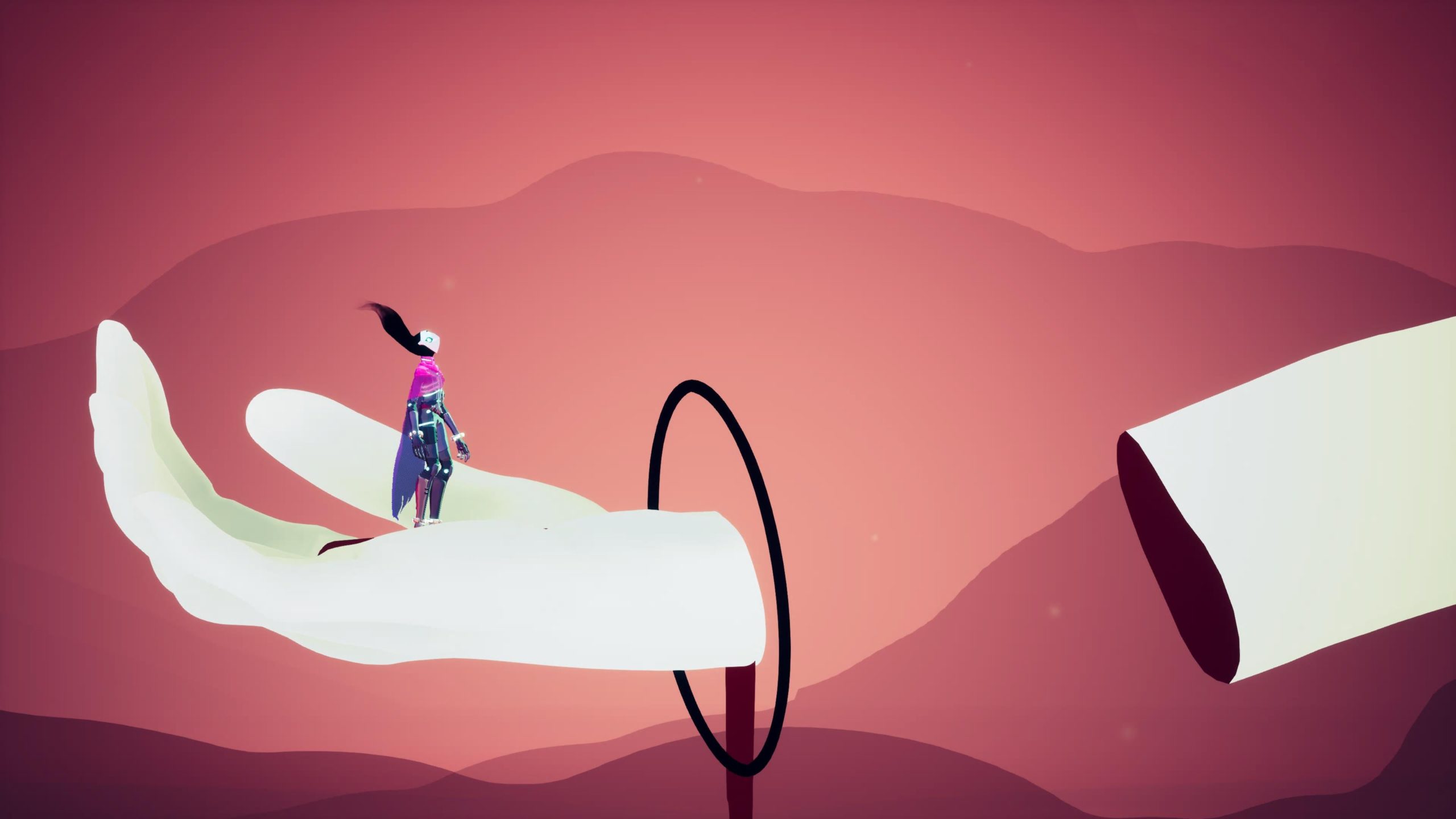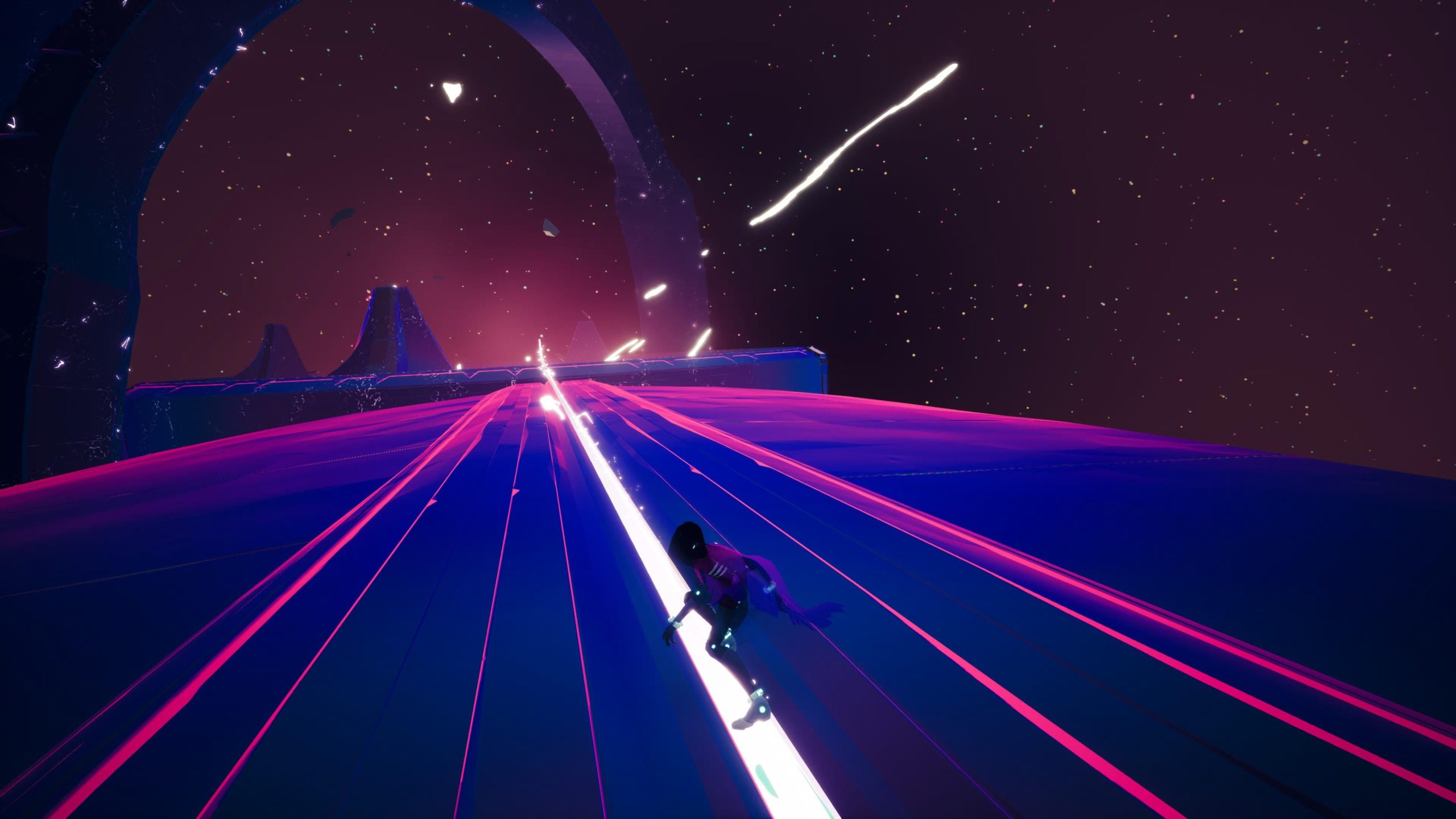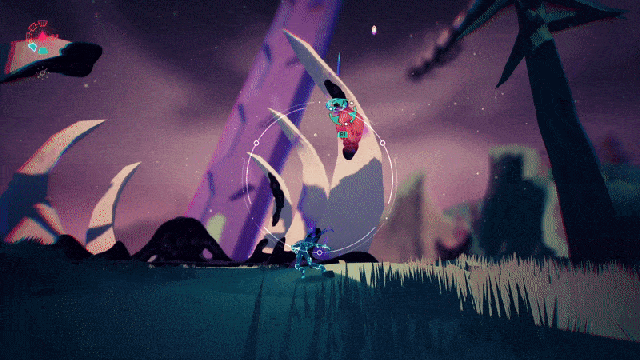I almost pulled the plug on Solar Ash before it really began. For the most part, I’m glad I did not.
Out tomorrow for PlayStation 4, PlayStation 5, and PC, Solar Ash — a game as fascinating as it is frustrating, as thrilling as it is calming, as straightforward as it is deeply convoluted — is an exercise in contrasts. One minute, you’re speed-skating across pastel-coloured space clouds suspended and warped by a gravitational anomaly, mouth agape at the sheer beauty of it all. The next, you’re banging your head against the nearest desk.
Solar Ash is the latest from Heart Machine, the indie outfit behind 2016’s pixel-art gauntlet of the year, Hyper Light Drifter. It’s published by Annapurna Interactive, and fits neatly among that company’s portfolio of offbeat if well-publicised games: the rhythm game Sayonara Wild Hearts, the exploratory enigma Outer Wilds, the puzzlers Gorogoa and Maquette, the open-world adventure The Pathless, and the forthcoming cat-paw-calypse simulator Stray. In the strictest sense, Solar Ash is a 3D platformer, though it often comes across as an action or a puzzle game.
You’re cast as a Voidrunner (basically, an astronaut who can ice-skate really well) named Rei, sent on a mission to save the world. Rei’s home planet is caught in a vortex called the Ultravoid, which threatens to rip it apart atom by atom. To prevent that from happening, because it sounds not-ideal, Rei needs to activate an enigmatic monolith called the Starseed.
Not the sort of quest you’d want to give up on at the start, right? About that…
[review heading=”Solar Ash” image=”https://www.gizmodo.com.au/wp-content/uploads/sites/3/2021/12/02/9714480146ccfe32c8fa3e91fcad5c44.jpg” label1=”Back-of-the-box Quote” description1=””If nothing else, you’ll get some banger screenshots.” – Kotaku” label2=”Type of game” description2=”An ex-skateboarder’s existential crisis” label3=”Liked” description3=”Comically gorgeous at all times, plus the rail-grinding sections can be a hoot” label4=”Disliked” description4=”Imprecise controls, uneven storytelling, almost does something totally new but never quite gets there” label5=”Developer” description5=”Heart Machine” label6=”Platforms” description6=”PS4, PS5 (played), PC” label7=”Release date” description7=”December 2, 2021″ label8=”Played” description8=”Around 8 hours on the clock for 77 per cent total completion before The Incident” ]
Within minutes of the exposition crawl, I hit a wall. Typically, when you’re stuck in a game, when you’ve contorted your brain to test every solution you can possibly think of, you might avail yourself of the various walkthroughs that clutter Google’s front page. Hey, no shame! We’ve all done it. But when you’re playing a game in the pre-release period, those pieces haven’t been published yet, so there’s little recourse to pinpoint an exact solution.
After an hour or so, I finally figured it out, but still: That exasperating hour turned out to be largely representative of my time with Solar Ash.
So, what happened? The game’s first area is a canyon with three environmental puzzles, puddles of simmering jet-black goo, fittingly called “black ooze challenges.” One of them denotes a clear tutorial; it teaches you to hit R1 (on PlayStation) to grapple to specific points, and to hit circle (yep, still on PlayStation) to engage something called a time slip, which kicks off a sort of Matrix-style bullet time, extending the range of your grappling hook and allowing you a moment to precisely line it up with your target.
The other two challenges aren’t so clear. In Solar Ash, black ooze also indicates climbable surfaces — totally safe to stay on as long as you please. But if you stay on the goo of a black ooze challenge for too long, it heats up and kills you, sending you back to your previous checkpoint.
I kept climbing and dying and climbing and dying. I’d beat my head against one challenge, die a million times, get frustrated, throw in the towel, then run to the other challenge, only to repeat the cycle there. I’d gotten it in my head that all of the puzzles in the starter area were in service of tutorials, to establish the whole “here’s how to use a grappling hook” lesson established just prior, but neither of the other two puzzles had prompts similar to the first one.
Turns out, all I had to do was hit this (incandescently bright) marker with my sword:

I didn’t figure out the solution via trial and error but, rather, by viewing some pre-release trailers for the game. One of them featured a similar-looking marker. Puzzle solved. Kind of.
Such black ooze challenges comprise the bulk of what you do in Solar Ash. Each region follows an identical framework. Every time you end up in a new area, you track down all of the nearby puzzles either via exploration or a handy scanner. (No region has more than half a dozen or so.) Once you start one, you have a limited time frame, marked by a slow-filling gauge, to climb, dash, and grapple your way to the end, slashing a series of those confounding but incandescent markers along the way. Some challenges have you grind rails, or jump across platforms that look like isolated islands of bone; the toughest feature a combination of all traversal elements. And the timing window is often tighter than a boa’s grip; I turned the difficulty down to help out with a particularly frustrating one and just left it that way for the rest of the game. (Lowering the difficulty doesn’t ease things up in terms of platforming but does marginally increase the allotted time frame.)
Completing all of a region’s challenges awakens the boss associated with that area — a slumbering, galactically scaled creature, called a “massive anomaly,” that meanders around the region. These boss fights essentially play out as three subsequent black ooze challenges, except you’re on a moving creature, rather than on flat ground (or, uh, cloud). The catch is that, during the third round, touching the black ooze sends you right back to the start of the round.
At least on PS5, the controls are a bit too slippery for a game with such exacting platforming demands, and Solar Ash isn’t forgiving enough to compensate for even the most minor errors. I’d direct Rei to dash into a double jump, and she’d dash just a hair too far. I’d try to have Rei slash a passing marker, but she’d slide right past it, often. Just stop!, I’d shout. She would never listen. (Points for consistency?) Even with the difficulty set as low as possible, I still found myself trying the final stages of every boss fight over and over and over again.
This isn’t to say that games shouldn’t be difficult, or should always be so catering to the player — or even that I personally can’t enjoy getting run through the wringer. (For context, roguelikes like Hades, Dead Cells, and Returnal are my comfort food.) I’ve just always been of the mindset that, if a game is gonna kick your arse, it should always make you feel like success is within reach, and that any failures should land squarely at the feet of the player. So often in Solar Ash, I felt like failure wasn’t my fault.
Solar Ash does a tremendous job at conveying the true scale of these anomalies. And every one takes the form of some beast of yore. I often found myself steeped in anticipation at what I’d see in the next fight. One’s a flying serpent? Hell yeah! What’s next? A giant with a sword? Sick! And this one, it’s a dragon! So cool! That you’re hundreds of meters above the ground (whoops, cloud) only makes each scene even more breathtaking.
Solar Ash falters, however, in conveying anything deeper than “kill big thing” in its boss fights. There’s a true melancholic undercurrent in each that Solar Ash never spends more than a few seconds on. Rei will regularly remark how these creatures seem like they’re feeling human feelings — how they’re so sad and frightened and inconsolably despondent in the face of certain death — but will never do anything with that information. She just stays the course, kills them without a second thought. In all of these fights, Solar Ash veers so, so close to commenting on the nature of death, then backs away at the last second, opting instead to stick with “kill big thing.”
But that’s in line with the rest of Solar Ash’s narrative yarn, which ranges from pointedly expository (do you think I’m stupid?) to pointedly vague (…OK, turns out maybe I am, please tell me what’s going on). To wit, after each boss fight, you’re summoned to some immaterial realm. There, you meet a woman named Echo, who’s the size of a massive anomaly and has a spear jutting out of her heart. She speaks in midwest emo lyrics and alludes to something greater at play, but ruins your day before ever fully elaborating on the things she says.
Typically, adventure games reward you for defeating bosses, right? Not so with Solar Ash. Every time you see her, Echo will eliminate one of your hearts. Think of it like the inverse of Zelda bosses giving you an extra heart after every boss. (To restore any lost health, you’ll have to find enough in-game currency, shaped little globules of blood, to buy it back at each region’s hub terminal.) This sounds annoying, and it kind of is, but a part of me enjoyed it. If anything, it means the story has a meaningful, hard-felt impact on how you play the game. You might not understand why. But at least the two are intertwined.

You can fill in the blanks of Solar Ash’s plot with various secondary stories, none of which are required for beating the game but all of which have a self-contained narrative. One stars a stalwart military commander who needs help finding a cadre of missing away teams; another has you trying to track down the final members of a long-forgotten race of demigods. Every region further features a series of collectible items — parts of stat-boosting suits worn by Rei’s cohorts who travelled with her to the Ultravoid — that come complete with story-padding audio logs. But I only saw one of Solar Ash’s side stories through to completion because…
OK. Look. If you’re planning on playing the game, do yourself a favour and backup your save files.
Minor spoilers follow for Solar Ash.
Without fully blowing the lid on the preceding events, my game froze up during the final cutscene — the audio stopped short, the screen flashed white, I couldn’t open the in-game menu, none of the buttons on my DualSense registered any input. When I restarted the game from my PS5’s home screen…my save file was gone!
Poof! Absorbed by the Ultravoid!
A representative for Heart Machine told me that it’s the result of a rare bug affecting some PS5 players in North America, and said that it should be fixed for launch. (Solar Ash will receive a day-one patch.) I’ll admit, though, before I received clarification, I found myself spending a lot of time wondering if a wholesale elimination of save data was an intentional design choice in the vein of, say, Nier: Automata’s audacious and memorable “E” ending.
That’s mostly because Solar Ash is an unabashedly oddball game, and a creative swerve like that would indeed track thematically. You see, Solar Ash is one of those games that gives you a binary good-or-bad choice after the final boss. I, apparently, chose the “good” route. And without spoiling how it goes down, turning my save file to digital ash would’ve been a perfect finale.

Heart Machine sent me video footage of how the final minutes would’ve played out. Sure enough, my game had crashed a minute and 49 seconds before the credits. I wouldn’t have missed much: some B-roll of the side characters, some major-key synth music, a monologue that puts a tidy bow on the game.
Here’s the thing, though: Even though I may be one of very few players who ever experience this bug, I can’t pretend that it wasn’t part of how I experienced Solar Ash, and that the ambiguity around whether it was intentional or not — which I lived with for many hours after completing the game — didn’t impact how I thought and felt about it. Now that I know for sure I ran into a rare bug, I kind of wish my save file was deleted purposefully. Yes, that would’ve been a bummer. (My side-quests!) But at the same time, I’d have to hand it to Heart Machine for taking such a bold creative stance. Instead, I ran into an ending that, while lovely, treads the same ground as so many other games. Had Solar Ash legitimately wiped my save data, I could confidently say the ending would stick with me for years. The one I got? Well…
Ultimately, Solar Ash left me in similar standing as the protagonist: a little awed, a little confused, a little satisfied, a little frustrated, wishing I fully understood this thing that doesn’t want to be fully understood, that so badly wants to go where few have gone before, yet backs away moments before taking the leap.

Leave a Reply